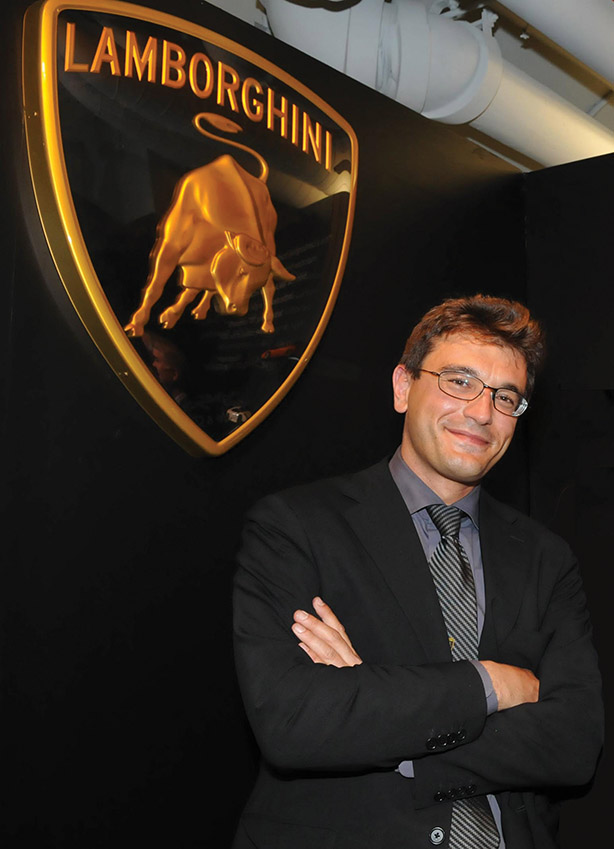Supercars in Seattle
Lamborghini’s advanced research is pushing the limits of composites in vehicle design
Previous Article Next Article
By Jon Evans
Supercars in Seattle
Lamborghini’s advanced research is pushing the limits of composites in vehicle design
Previous Article Next Article
By Jon Evans
Supercars in Seattle
Lamborghini’s advanced research is pushing the limits of composites in vehicle design
Previous Article Next Article
By Jon Evans

Lamborghini’s Aventador and Huracán in action at this year’s Goodwood Festival of Speed in West Sussex, England.

Lamborghini’s Aventador and Huracán in action at this year’s Goodwood Festival of Speed in West Sussex, England.

Paolo Feraboli, ACSL director.

The Lamborghini Aventador’s CFRP chassis, at right being shown off at the European Patent Office.

The Lamborghini Aventador’s CFRP chassis, at right being shown off at the European Patent Office.

The Lamborghini Aventador’s CFRP chassis, at right being shown off at the European Patent Office.

The Lamborghini Aventador LP-700-4.

The Lamborghini Aventador LP-700-4.
Lamborghini may be a maker of quintessentially Italian “supercars,” but its latest models owe almost as much to the Northwest USA as they do to Italy. Over the past few years, Lamborghini has made a conscious decision to increase the proportion of carbon fiber-reinforced plastic (CFRP) in its cars, as way to reduce weight and thus increase both acceleration and fuel efficiency. And the technology that has allowed them to do this was developed in a laboratory in Seattle, Washington.
There’s still an Italian connection, though, because this laboratory, known as the Advanced Composite Structures Laboratory (ACSL), was founded and is still led by Paolo Feraboli, who hails originally from Italy. Lamborghini invited Feraboli to establish the laboratory in 2007, after he had spent a couple of years developing aircraft parts made from CFRP for Boeing, with the aim of developing the first car chassis made entirely of CFRP.
“They came to me and said, ‘We want to make the best Lamborghini ever made utilizing these new technologies and processes and materials and design criteria that you developed with the aerospace world,’” recalls Feraboli.
The end result was Lamborghini’s Aventador, launched in 2011, which boasts a monocoque chassis made entirely from CFRP. This helps the Aventador accelerate to 60 mph (97 km/hr) in less than three seconds. In addition, many other important components are also constructed from CFRP, including the engine bonnet, spoiler, and side air inlets.
The experience of producing the Aventador subsequently fed into the development of Lamborghini’s next model, the Huracán, launched in 2014. Although the Huracán doesn’t contain CFRP to the same extent as the Aventador, its frame is made from a blend of aluminium and CFRP, and many other components are made entirely from CFRP, including the rear firewall and the ‘B’ pillar.
The Traditional CFRP Process
In truth, Lamborghini has been using CFRP in its cars for several years, but prior to the Aventador it was only used for exterior body panel applications, not for producing major structural components.
“CFRP had always been used for parts that were relatively secondary,” explains Feraboli. “The reason was that traditional CFRP could not be fully understood and predicted, and producing primary applications was costly and risky. All of those things combined have always limited the use of CFRP for primary structures.” The high cost of CFRP was also a factor, even for a supercar that costs hundreds of thousands of dollars.
These factors have also restricted the use of CFRP by the aerospace industry, even though the need to reduce weight by replacing metals with lighter materials is even more pressing in commercial airliners than in supercars.
Part of the problem is the way that CFRP has traditionally been made. The carbon fibers are derived from a polymer such as polyacrylonitrile, which is first spun into filament yarns and then heated to drive off hydrogen and nitrogen. This produces a yarn consisting solely of carbon fibers, each 5-6 μm in diameter and ideally all aligned in the same way in order to maximize strength. This yarn is woven into a sheet, which can be cut into a desired shape.
Liquid plastic is then applied to the sheet before it’s cured in an autoclave at high temperatures and pressures, in a process known as pre-preg, to produce the desired CFRP part. Commonly used plastic resins include thermosetting resins such as epoxy and vinyl ester. The trouble with the pre-preg process is that it’s quite labor-intensive and therefore expensive, particularly the autoclave step.
Cheaper production processes, collectively known as “out of autoclave,” are now becoming available. An increasingly popular process for CFRP production is resin transfer molding (RTM). This involves placing one or more layers of cut carbon fiber sheet inside a mold and then injecting plastic resin at high temperatures and pressures, after which the temperature inside the mold is raised to cure the plastic.
Both these production process produce high-strength composite parts, but this strength quickly drops if there is any damage to the CFRP or defects in it. This also happens if any holes are drilled through the part so it can be fastened to other components, which is a common requirement when making aircraft or cars. “As soon as you put a hole in the material, such as for a fastener, traditional CFRP, whether pre-preg or RTM, drops its strength by at least 40%, but in some cases even 50% or 60%,” says Feraboli. “So when you design parts you have to account for that.”
Chopped Carbon Fiber
Another way of reducing the production cost is by using what is known as chopped carbon fiber. This again is produced by the pre-preg process, but rather than the sheet being cut into small desired shapes and being placed into the mold one step at a time, it’s simply chopped into small pieces, which are placed in the mold at once and compressed at high pressure. Chopped carbon fiber offers a simple and cheap way to produce CFRP components with complex shapes, as the pieces can fit into all the nooks and crannies of a mold.
Unfortunately, CFRP parts made from chopped carbon fiber tend to be inherently weaker than CFRP parts made from whole sheets, because the carbon fibers are shorter and aligned in different directions in different pieces. “Chopped carbon fiber has lower tensile strength than traditional CFRP,” explains Feraboli, “so if you look at the data sheet for chopped carbon fiber you’ll see that certain strength values are as low as half compared to pre-preg or RTM materials.”
Nevertheless, when he began collaborating with Boeing while a professor at the University of Washington in Seattle (with the aim of increasing the use of CFRP parts in aircraft like the Boeing 787), Feraboli decided to experiment with chopped carbon fiber. “When we started working with this in 2006, the aerospace community was not ready for it, and they disregarded the possibility that chopped carbon fiber would have a future for primary structures,” he says.
The approach he took was to focus on what chopped carbon fiber could do, rather than on what it couldn’t. “The key is to look at how a material behaves when designed in a certain way and for a given part.”
This led Feraboli to discover that in one important respect chopped carbon fiber actually performs better than CFRP made from carbon fiber sheets. “The unique thing about chopped carbon fiber is that you can drill as big a hole as you want into the CFRP and it doesn’t care; you can damage it and you can have defects in it, and it won’t care.…
“So if you’re trying to make a CFRP skin that’s just glued to a surface, chopped carbon fiber is not the right application for you.” But for making a complex part that has a lot of holes for fastening, chopped carbon fiber “becomes very advantageous.”
“Forged Composite”
Feraboli then took this approach with him when he started working with Lamborghini, while also refining and improving the chopped carbon fiber production process. In addition, he and his team at ACSL developed a modified version of RTM, known as Lambo RTM. The end result was a novel CFRP technology known as Forged Composite.
“Forged Composite is not a specific material and it’s not a single process, it’s a set of material characteristics and process specifications and knowledge, meaning engineering and design knowledge, that only [when] fused together will allow us to achieve Forged Composite,” he explains. “It’s a revolution in CFRP compounds.”
The name Forged Composite was chosen both because the technology utilizes high pressure to produce the CFRP parts, thus resembling metal forging, and because these parts are designed to replace forged metal parts.
Using the Forged Composite technology, Lamborghini is now able to make primary components for its cars from CFRP, such as the Aventador chassis. The development and design of these parts actually takes place at a different R&D center: the Advanced Composite Research Center (ACRC) in Sant’Agata Bolognese, Italy. “We, as ACSL, are a supplier of knowledge, not a supplier of parts and cars,” Feraboli says. “The ACRC, on the other hand, is the organization that develops the parts and the cars.”
Indeed, ACSL has a rather hands-off relationship with Lamborghini. “ACSL is a stand-alone R&D organization and is not in the company’s direct organizational chart,” he remarks. “Because of that, it has freedom to pursue high-risk and high-value targets for the company.”
Nevertheless, ACSL only works for Lamborghini, and so Feraboli has also set up a company called Gemini Composites, which is co-located on the ACSL site, to bring Forged Composite technology to other companies. Some of these other companies are car makers, such as Honda and Volvo, but Gemini Composites has also helped produce a range of sporting goods in CFRP, including golf clubs for Callaway and snowboard bindings for Union Binding Company.
The relationship between Feraboli and Lamborghini may be hands-off, but it remains very strong, as evidenced by the fact that he drives one of their cars: a 2012 Gallardo. “Of course I’m partial to Lamborghini,” he confesses, “because my work is there and my heart is there.”
